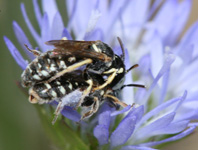Abstract
Flavipanurgus is a small genus of panurgine bees known only from the Iberian Peninsula. Despite its status as one of the few bee genera endemic to Europe, Flavipanurgus are poorly represented in collections and until recently, their ecology had been almost unknown. Flavipanurgus ibericus (Warncke, 1972) was described from southern Iberia, with a northern subspecies F. i. kastiliensis (Warncke, 1987) later described from the north. Recent collections in Portugal have revealed clear differences in the pollen collecting patterns of the two taxa, with southern females collecting exclusively from Jasione montana and northern females from Sedum species. In combination with this ecological difference, COI and 28S barcode data indicate that Flavipanurgus kastiliensis stat. nov. should be raised to full species status. The male of Flavipanurgus ibericus s. str. is described for the first time, and updated keys to Flavipanurgus species are provided. Flavipanurgus fuzetus Patiny, 1999 is recorded for the first time from Spain. Further significant records and new floral associations for Flavipanurgus are also presented.
References
Danforth, B.N., Cardinal, S., Praz, C., Almedia, E.A.B. & Michez, D. (2013) The impact of molecular data on our understanding of bee phylogeny and evolution. Annual Review of Entomology, 58, 57–78.
https://doi.org/10.1146/annurev-ento-120811-153633Ebmer, A.W. (1984) Die westpaläarktischen Arten der Gattung Dufourea Lepeletier 1841 mit illustrierten Bestimmungstabellen (Insecta: Hymenoptera: Apoidea: Halictidae: Dufoureinae). Senckenbergiana biologica, 4 (4/6), 313–379.
Flora-On: Flora de Portugal Interactiva (2014) Sociedade Portuguesa de Botânica. Available from: http://flora-on.pt/#/1 (accessed 1 August 2018)
Hajibabaei, M., deWaard, J.R., Ivanova, N.V., Ratnasingham, S., Dooh, R.T., Kirk, S.L., Mackie, P.M & Hebert, P.D.N. (2005) Critical factors for assembling a high volume of DNA barcodes. Philosophical Transactions of the Royal Society B, 360, 1959–1967.
https://doi.org/10.1098/rstb.2005.1727Hajibabaei, M., Smith, M.A., Janzen, D.H., Rodriguez, J.J., Whitfield, J.B. & Hebert, P.D.N. (2006) A minimalist barcode can identify a specimen whose DNA is degraded. Molecular Ecology Notes, 6, 959–964.
https://doi.org/10.1111/j.1471-8286.2006.01470.xHebert, P.D.N., Penton, E.H., Burns, J.M., Janzen, D.H. & Hallwachs, W. (2004) Ten species in one: DNA barcoding reveals cryptic species in the neotropical skipper butterfly Astraptes fulgerator. Proceedings of the National Academy of Sciences, 101, 14812–14817.
https://doi.org/10.1073/pnas.0406166101Kuhlmann, M., Else, G.R., Dawson, A. & Quicke, D.L.J. (2007) Molecular, biogeographical and phenological evidence for the existence of three western European sibling species in the Colletes succinctus group (Hymenoptera: Apidae). Organisms, Diversity & Evolution, 7, 155–165.
https://doi.org/10.1016/j.ode.2006.04.001Kumar, S., Stecher, G., Li, M., Knyaz, C. & Tamura, K. (2018) MEGA X: Molecular evolutionary genetics analysis across computing platforms. Molecular Biology and Evolution, 35, 1547–1549.
https://doi.org/10.1093/molbev/msy096Michener, C.D. (2007) The Bees of the World. 2nd Edition. John Hopkins University Press, Baltimore, 953 pp.
Müller, A. (2017) Palaearctic Osmiine Bees. ETH Zurich, Available from: http://blogs.ethz.ch/osmiini (accessed 1 August 2018)
Patiny, S. (1999a) Etude phylogénétique des Panurginae de l’ancien monde (Hymenoptera, Andrenidae). Linzer Biologische Beiträge, 31, 249–275.
Patiny, S. (1999b) Description d’une nouvelle espèce de Flavipanurgus Warncke, 1972 (Hymenoptera, Andrenidae, Panurginae). Notes fauniques de Gembloux, 37 57–61
Patiny, S. (2012) Atlas of the European Bees: genus Flavipanurgus. STEP Project, Atlas Hymenoptera, Mons, Gembloux. Available from: http://www.zoologie.umh.ac.be//hymenoptera/page.asp?ID=24 (accessed 1 August 2018)
Rozen Junior, J.G. (1967) Review of the biology of panurgine bees, with observations on North American forms (Hymenoptera: Apoidea). American Museum Novitates, 2297, 1–44.
Rozen Junior, J.G. (1971) Biology and immature stages of Moroccan panurgine bees (Hymenoptera: Apoidea). American Museum Novitates, 2457, 1–37.
Schmidt, S., Schmid-Egger, C., Morinière, J., Haszprunar, G. & Herbert, P.D.N. (2015) DNA barcoding largely supports 250 years of classical taxonomy: identifications for Central European bees (Hymenoptera: Apoidea partim). Molecular Ecology Resources, 15, 985–1000.
https://doi.org/10.1111/1755-0998Smith, P.T. & Brown, B.V. (2008) Utility of DNA sequences for inferring phylogenetic relationships and associating morphologically dissimilar males and females of the bee-killing flies, genus Melaloncha (Diptera: Phoridae). Annals of the Entomological Society of America, 101, 713–721.
https://doi.org/10.1093/aesa/101.4.713Vanderplank, M., Vereecken, N.J., Grumiau, L., Esposito, F., Lognay, G., Wattiez, R. & Michez, D. (2017) The importance of pollen chemistry in evolutionary host shifts of bees. Scientific Reports, 7, 43058.
https://doi.org/10.1038/srep43058Warncke, K. (1972) Westpaläarktische Bienen der Unterfamilie Panurginae (Hym., Apidae). Polskie Pismo Entomolgiczne, 52, 53–108.
Warncke, K. (1987) Ergänzende Untersuchungen an den Bienen der Gattungen Panurgus und Melitturga/Andreninae, Apidae, vor allem dem türkischen Raum. Bolletino del Museo Civico di Storia Naturale di Venezia, 36, 75–107.
Westrich, P. (1989) Die Wildbienen Baden-Württembergs. Eugen Ulmer, Stuttgart, 972 pp.
Wood, T.J. & Cross, I. (2017) Camptopoeum (Camptopoeum) baldocki spec. nov., a new panurgine bee species from Portugal and a description of the male of Flavipanurgus fuzetus Patiny (Andrenidae: Panurginae). Zootaxa, 4254 (2), 285–293.
https://doi.org/10.11646/zootaxa.4254.2

